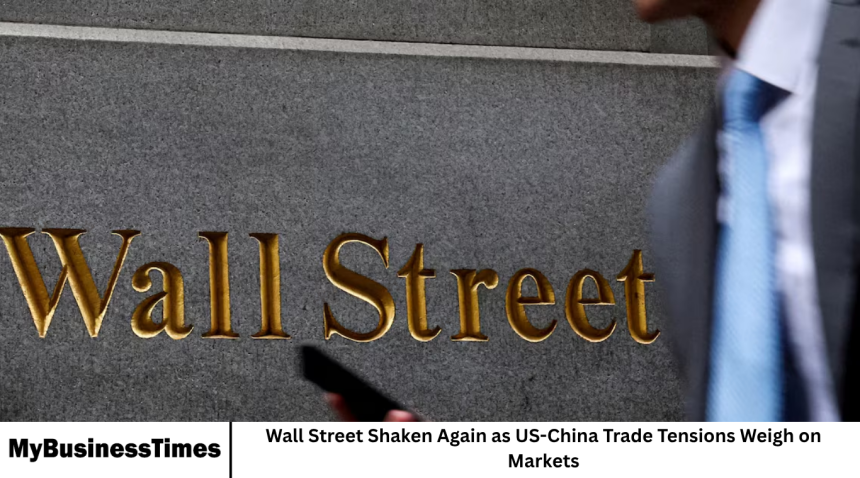Wall Street experienced another wave of turbulence as renewed tensions between the United States and China rattled investor confidence. Concerns over trade restrictions, technology disputes, and uncertain diplomatic relations have reignited fears of a prolonged economic slowdown. Major stock indices fell sharply as traders reacted to signs of growing friction between the two largest economies in the world.
The market turmoil underscores how sensitive global investors remain to U.S.-China relations. With both nations holding significant influence over global supply chains, technology development, and international trade, any disruption between them sends ripples across global markets.
Renewed Strain in U.S.-China Relations
Recent statements from both Washington and Beijing have reignited the ongoing trade and technology conflict. The U.S. government has reportedly considered expanding restrictions on China’s access to advanced semiconductors and AI-related technologies. In response, China signaled potential retaliatory measures, including stricter export controls on key materials and technology components.
This back-and-forth has revived memories of the 2018–2019 trade war, when tariffs and sanctions disrupted global trade and affected multiple industries. The uncertainty surrounding the latest developments has left investors uneasy, leading to a selloff in major U.S. stock markets.
Stock Market Reactions
Wall Street’s major indices reflected widespread investor anxiety. The Dow Jones Industrial Average, S&P 500, and Nasdaq Composite all recorded declines, with technology stocks being hit the hardest. Semiconductor companies, which depend heavily on global trade, saw notable drops in share value.
Investors are increasingly turning to safe-haven assets such as gold and U.S. Treasury bonds, signaling a shift toward caution. Currency markets also showed movement, with the dollar strengthening slightly as traders sought stability amid geopolitical uncertainty.
Analysts warn that if tensions escalate further, markets could face extended volatility. The fear of prolonged tariffs or supply chain restrictions has led many institutional investors to rebalance their portfolios toward defensive sectors such as utilities, healthcare, and consumer staples.
Technology Sector Under Pressure
The technology sector, a key driver of the U.S. economy, is once again at the center of the trade dispute. The U.S. government’s ongoing efforts to limit Chinese access to advanced chips and AI hardware are creating uncertainty for major tech firms.
Companies involved in semiconductor manufacturing, such as NVIDIA, Intel, and AMD, are facing renewed scrutiny over potential export restrictions. Meanwhile, Chinese firms in telecommunications and AI development are preparing for possible disruptions in supply chains and product launches.
Investors are concerned that extended trade restrictions could slow innovation and limit growth opportunities in the global technology market. Experts also note that both the U.S. and China risk losing valuable partnerships and research collaborations if the divide continues to widen.
Economic Implications for Global Trade
The escalating tensions have broader implications for global trade and manufacturing. China remains a vital hub for production and exports, while the U.S. continues to lead in technological innovation. Any breakdown in cooperation could lead to higher production costs, delays, and reduced profitability across multiple industries.
The manufacturing, electronics, and automotive sectors are particularly vulnerable. Many multinational corporations depend on Chinese suppliers for raw materials and intermediate goods. A tightening of export controls or import restrictions could disrupt production timelines and increase costs for consumers worldwide.
Financial experts caution that global supply chains are still recovering from previous trade disruptions and the COVID-19 pandemic. Renewed tensions could delay that recovery, affecting long-term investment strategies and economic growth forecasts.
Investor Sentiment and Market Volatility
Investor confidence remains fragile amid the uncertainty. Volatility indices, such as the VIX, have risen sharply as traders brace for further market swings. Short-term investors are increasingly hedging positions, while long-term investors are monitoring the situation closely before making major commitments.
Market analysts emphasize that investor behavior in times of geopolitical tension often follows predictable patterns. Typically, investors move away from riskier assets like equities and cryptocurrencies and instead seek stability in government bonds, gold, and major currencies like the U.S. dollar and Swiss franc.
Despite the ongoing turbulence, some analysts see potential buying opportunities for investors willing to weather short-term volatility. They argue that quality companies with strong balance sheets and diversified global operations may rebound once tensions ease.
Impact on Commodities and Currency Markets
The geopolitical friction between the U.S. and China is also affecting commodities. Oil prices have fluctuated amid concerns that slower global trade could reduce energy demand. Meanwhile, gold has surged to multi-month highs as investors seek safe-haven assets.
In the currency markets, the Chinese yuan has weakened slightly against the dollar, reflecting concerns about the impact of potential U.S. trade measures. The dollar index, on the other hand, strengthened as global investors turned to U.S. assets for security.
Analysts predict that if the situation worsens, emerging market currencies could also come under pressure, especially those closely tied to global manufacturing and exports.
Corporate Reactions and Strategic Adjustments
Many multinational corporations are reassessing their strategies in light of the renewed trade tensions. Some U.S. and European companies are accelerating efforts to diversify supply chains away from China by moving production to other countries in Asia, such as Vietnam, India, and Malaysia.
Meanwhile, Chinese companies are increasing investment in domestic technology and manufacturing to reduce dependence on Western suppliers. The Chinese government has emphasized self-reliance in key industries such as semiconductors, renewable energy, and electric vehicles.
This gradual separation, often described as “economic decoupling,” could reshape the structure of global trade and competition for decades to come.
The Role of Policy and Diplomacy
Political analysts stress that the path forward will depend largely on diplomatic engagement. Both the U.S. and China face internal economic challenges — from inflation and labor shortages in the U.S. to property market instability and sluggish growth in China. As a result, experts believe that both sides have strong incentives to avoid a full-scale trade conflict.
Recent attempts at dialogue, including high-level talks between U.S. and Chinese officials, suggest that both governments recognize the need to manage tensions carefully. However, issues like technology transfer, intellectual property, and security concerns remain difficult to resolve.
Global organizations and trade partners are urging the two powers to maintain open communication channels to prevent a deeper economic rift.
Potential Scenarios for Markets
Economists are considering several possible scenarios. In a best-case situation, both nations may agree on limited compromises that allow trade and technology cooperation to continue under stricter oversight. This outcome would likely stabilize global markets and restore investor confidence.
In a more pessimistic scenario, if restrictions expand and retaliatory measures intensify, markets could face another prolonged downturn similar to the 2018 trade war. This could trigger lower corporate profits, higher inflation due to disrupted supply chains, and slower global growth.
Investors are therefore keeping a close eye on upcoming policy announcements, economic data, and diplomatic meetings that could shape the direction of U.S.-China relations.
Long-Term Outlook
Despite the short-term uncertainty, most analysts agree that both economies remain deeply interconnected. The U.S. continues to rely on China for manufacturing and materials, while China depends on U.S. technology and access to global financial markets.
Long-term stability will require careful policy coordination and mutual economic compromise. As global supply chains evolve, some level of competition is inevitable, but a complete separation between the two economies remains unlikely.
Financial experts predict that markets will continue to fluctuate until a clearer diplomatic path emerges, but they also highlight that periods of volatility often create opportunities for strategic investors.
Frequently Asked Questions
What caused the latest market decline on Wall Street?
The latest decline was triggered by renewed U.S.-China trade tensions, including potential restrictions on technology exports and retaliatory measures from Beijing.
Which sectors were most affected?
Technology and manufacturing sectors were hit the hardest due to their dependence on global supply chains and trade relations with China.
How have investors reacted to the news?
Investors have shifted toward safe-haven assets such as gold and U.S. Treasury bonds, while reducing exposure to volatile equities.
Could this lead to another trade war?
Analysts believe a full-scale trade war is unlikely, but tensions could escalate further if diplomatic talks fail to produce results.
How does this affect the global economy?
Rising trade tensions can disrupt supply chains, increase production costs, and slow global growth, affecting both developed and emerging markets.
What should investors do during this period?
Experts advise maintaining a diversified portfolio, focusing on long-term fundamentals, and monitoring policy developments closely before making major investment decisions.
Conclusion
The renewed U.S.-China trade tensions have once again shaken Wall Street, highlighting the deep interdependence between the world’s two largest economies. The fallout from policy uncertainty and technology restrictions has affected global markets, investor confidence, and corporate strategies.
While the immediate outlook remains uncertain, experts stress that long-term cooperation and open dialogue are essential to maintaining global economic stability. As policymakers work toward easing tensions, investors and businesses alike are preparing for a future where resilience and diversification will be key to navigating an increasingly complex global economy.









